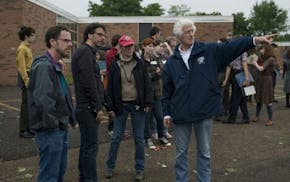Seated cross-legged on a round rug in a sunny classroom, 15 preschoolers and their three teachers played Memory, the classic matching game. The children took turns flipping over pairs of cards with animal pictures.
"Hund," a girl announced as she revealed the image of a dachshund.
Her next card showed a goose. "Und ... Gans?"
"Ja, Klara, der Hund und die Gans," said teacher Vincent Buettner.
It's circle time, or Kreis, at Kinderstube. The German immersion preschool, operated since 2004 by the St. Paul based Germanic-American Institute, provides a year-round, full-day program for ages 3 to 5 in classrooms in both Minneapolis and St. Paul.
Matz Fouquette, 3, attends twice a week on the days his mother works in downtown Minneapolis. Together they commute an hour and 15 minutes one-way from their home in Foley, Minn. Krista Fouquette, a computer analyst, often connects with international customers and has come to see foreign language skills as crucial.
"I've been trying to learn German as an adult," she said. "As hard as it has been for me, I thought, now is the time for him. And he is soaking it up."
"Many children have zero knowledge of German when they arrive," said Kinderstube director Katrina VanKempen. "Preschool children pick up words quickly and naturally grasp their context."
In the classroom, children sometimes speak to each other in English, or ask a question in a blend of the two languages. Teachers work to speak German only, often using grimaces, gestures or pantomime to communicate meaning.
"If a child is frustrated or needs comforting, of course we speak to them in English," Van Kempen said. "But they hear very little that isn't German."
Early language lessons
Traditionally, American students learn a second language during language class. In language immersion programs, children are taught in a second language for the duration of their day, regardless of subject matter.
Minnesota has been at the forefront of the elementary school immersion movement, with some of the nation's first and most extensive public school programs.
Now the Twin Cities area is seeing an expansion of programs using the immersion technique for the youngest learners, even the pre-verbal.
"Well-educated parents want this for their children," said Natalie Standridge-Lopez, who with her husband, Xavier, owns and operates Jardín Magico (Magic Garden), a Spanish immersion day care and preschool.
When the couple's first child was born 10 years ago, they sought bilingual day care. Surprised to find none existed, they started a licensed home day-care program for 14 children, including their own.
In 2006, Jardín Magico expanded to a center serving 150 preschoolers in Minneapolis' Longfellow neighborhood. A second Jardín Magico opened in the Kingfield neighborhood a few years later, and this year a third opened in Edina. The program now serves 400 families. All three centers are at capacity, with waiting lists.
"People call and say they're pregnant and haven't told their families yet, but can they get on our list," Standridge-Lopez said.
At Jardín Magico, babies as young as 6 weeks old are cared for by a staff of mostly native Spanish speakers.
"We see 1-year-olds with as many words in English as in Spanish. They build their vocabulary simultaneously and can follow directions before they can talk," Lopez-Standridge said. "With a stable environment of English at home and Spanish at school, they make positive progress in both languages. They advance and become bilingual."
Word by word
"Children learn to talk and talk to learn," said Kathryn Kohnert, an assistant professor in the Department of Speech Language Hearing Sciences at the University of Minnesota.
Kohnert studies language development in bilingual children. With the exception of the rare child with language delays or disabilities, she said there is no reason not to embrace immersion programs for preschoolers.
"But parents should not see this as a now-or-never proposition," she said. "It is a myth that there is a hard and fast critical age for language learning. There's plenty of time to learn later. It is true that language is just easier for children. Adults have inhibitions about trying something new and failing. It's a child's job to try and fail. Since everything is new to them, they have few apprehensions."
When evaluating a bilingual program, Kohnert urges parents to first look at the quality of care and ask questions about teacher training, staff longevity, school readiness activities and student-teacher ratios.
"A second language is the icing on the cake," Kohnert said. "It should be fun for the child. If it's not, the child won't learn."
Matz Fouquette's mother worried that her son would struggle when he switched from a traditional day-care center to the German immersion preschool earlier this year.
"I thought he would be nervous, but he's excited to come every day. He knows songs and rhymes and counts in German. He likes his friends. He embraces it."
And she has found one other benefit.
"He sleeps really well on the days he goes to Kinderstube," she said. "All the thinking wears him out!"
Kevyn Burger of Minneapolis is a broadcaster, podcaster and writer.
Spring's hot gift book features gorgeous found-nature photos

Jane Smiley hits again with 'Lucky' but what the what is that ending?

Biography details what 'Rulebreaker' Barbara Walters did to get to the top
